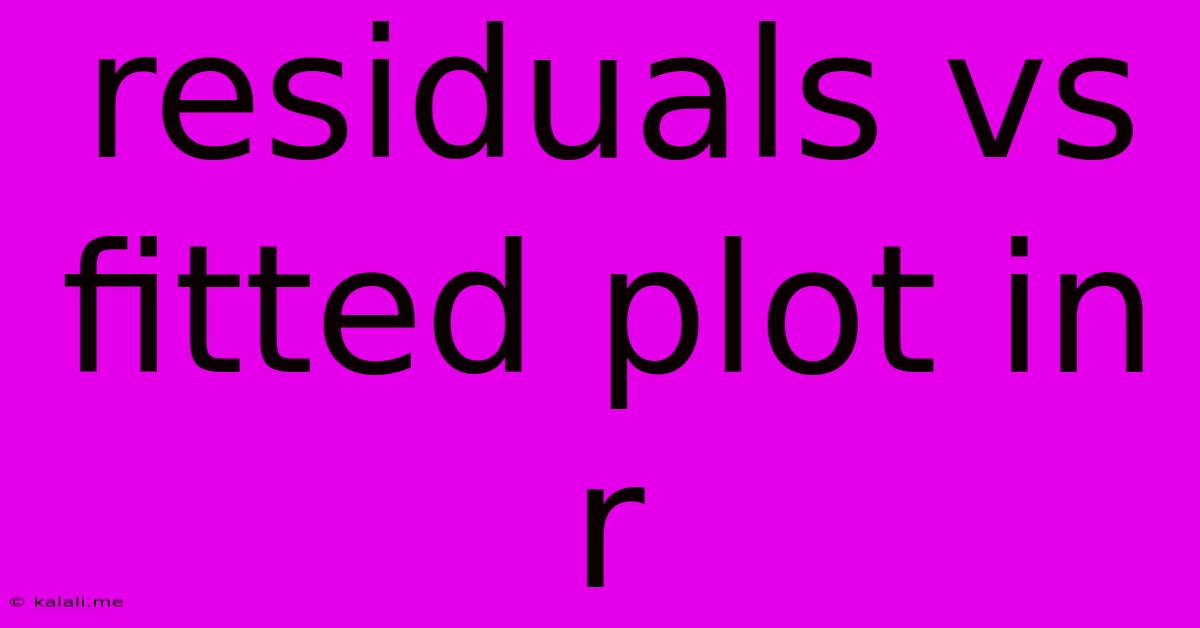Residuals Vs Fitted Plot In R
Kalali
Jun 04, 2025 · 4 min read

Table of Contents
Residuals vs. Fitted Plot in R: A Comprehensive Guide
Understanding the relationship between your model's predictions and the actual data is crucial for assessing the validity and reliability of your statistical model. A residuals vs. fitted plot is a powerful diagnostic tool in R that helps you visualize this relationship and identify potential problems. This article will guide you through creating and interpreting this plot, highlighting key features and common issues it can reveal.
This plot displays the fitted values (predicted values from your model) on the x-axis and the residuals (the differences between the observed and fitted values) on the y-axis. By examining the scatter of points, you can gain valuable insights into your model's assumptions and performance.
What are Residuals and Fitted Values?
Before diving into the plot itself, let's clarify these core concepts:
-
Fitted Values: These are the values predicted by your statistical model. They represent the model's best estimate of the dependent variable given the independent variables.
-
Residuals: These are the differences between the observed values of the dependent variable and the corresponding fitted values. Mathematically, residual = observed value - fitted value. Residuals essentially represent the error or unexplained variation in your model.
Creating a Residuals vs. Fitted Plot in R
Creating this plot is straightforward using the plot() function after fitting a model (e.g., using lm() for linear models). Here's an example:
# Sample data (replace with your own)
data <- data.frame(x = 1:10, y = c(2, 4, 5, 4, 7, 9, 8, 10, 12, 11))
# Fit a linear model
model <- lm(y ~ x, data = data)
# Create the residuals vs. fitted plot
plot(model, which = 1)
The which = 1 argument specifies that we want the first diagnostic plot, which is the residuals vs. fitted plot. R will automatically generate the plot, showing the fitted values on the x-axis and the residuals on the y-axis.
Interpreting the Residuals vs. Fitted Plot
An ideal residuals vs. fitted plot should show a random scatter of points around a horizontal line at zero. This indicates that the model's assumptions are likely met, and the model fits the data well. However, several patterns can indicate potential problems:
-
Non-constant Variance (Heteroscedasticity): If the spread of residuals increases or decreases as the fitted values increase, it suggests heteroscedasticity. This violates the assumption of constant variance and can affect the reliability of your model's inferences. You might see a cone or funnel shape in the plot.
-
Non-linearity: If the residuals show a clear curve or pattern, it suggests that the relationship between the dependent and independent variables is not linear. A linear model may not be appropriate in this case; consider transforming variables or using a non-linear model.
-
Outliers: Points far from the main cluster of residuals might indicate outliers that exert undue influence on your model. Investigate these points to determine if they are errors or represent genuine data points that require special consideration.
-
Non-normality: While the residuals vs. fitted plot doesn't directly assess normality, a strong pattern in the residuals can hint at non-normality. Further investigation using other diagnostic plots (e.g., a Q-Q plot) is recommended.
Addressing Issues Identified in the Plot
Depending on the patterns observed, several strategies can be employed to address the issues:
-
Transforming variables: Applying transformations (e.g., logarithmic, square root) to the dependent or independent variables can stabilize variance and address non-linearity.
-
Using weighted least squares: If heteroscedasticity is present, weighted least squares regression can be used to give more weight to observations with smaller residuals.
-
Removing outliers: If outliers are identified as errors, they can be removed. However, be cautious and justify the removal based on valid reasons.
-
Using different models: If non-linearity is substantial, consider using non-linear regression models.
Conclusion
The residuals vs. fitted plot is an invaluable tool for assessing the adequacy of your statistical model. By carefully examining the plot, you can identify potential violations of assumptions and make informed decisions about improving your model's performance and reliability. Remember to always consider the context of your data and the goals of your analysis when interpreting the plot and choosing appropriate remedies. Further analysis using other diagnostic plots is usually advisable for a comprehensive model evaluation.
Latest Posts
Latest Posts
-
Cinema 4d Get An Object To Bend Around A Circle
Jun 06, 2025
-
How To Get Rid Of A Mud Dauber Nest
Jun 06, 2025
-
Average Height Of 2 Year Old Girl
Jun 06, 2025
-
Hot Surface Light Stays On Stove Dangerous
Jun 06, 2025
-
How To Make Sure You Messages Are Stored In Icloud
Jun 06, 2025
Related Post
Thank you for visiting our website which covers about Residuals Vs Fitted Plot In R . We hope the information provided has been useful to you. Feel free to contact us if you have any questions or need further assistance. See you next time and don't miss to bookmark.